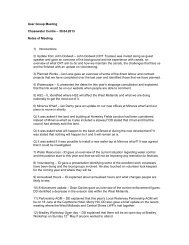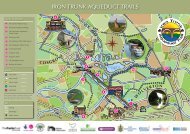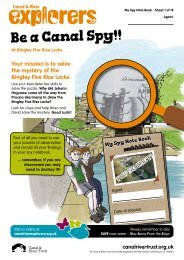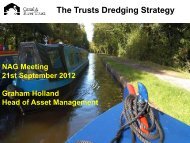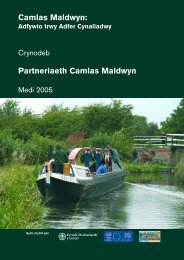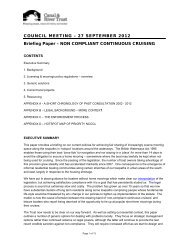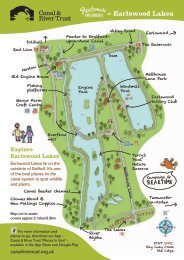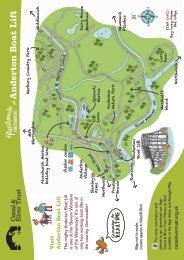Reserves Aquatic Macrophytes survey - Canal & River Trust
Reserves Aquatic Macrophytes survey - Canal & River Trust
Reserves Aquatic Macrophytes survey - Canal & River Trust
You also want an ePaper? Increase the reach of your titles
YUMPU automatically turns print PDFs into web optimized ePapers that Google loves.
Pond 4 was dominated by Potamogeton alpinus with Hydrocharis morsus-ranaebeing locally dominant. The edge was again dominated by Typha latifolia (Map 12).Pond 5 was more diverse but again was dominated by Potamogeton alpinus.Hydrocharis morsus-ranae Nuphar lutea and Sparganium emersum were locallydominant. Elodea canadensis was the only frequently found plant and Hottoniapalustris and Ranunculus circinatus were occasionally found. The edge wasdominated by Typha latifolia and Sparganium erectum with small areas of Nasturtiumaquaticum and Butomus umbellatus and one tussosk of Carex paniculata (Map 13).The narrowing of the pond towards the outflow had three small wettish depressionswhich were the only areas where Juncus sub-nodulosus and Carex rostrata werefoundPond 6 was dominated by Chara globularis and Ranunculus flammula withoccasional growths of Hydrocotyle vulgaris. The last two species reflect the acidnature of the soil (Map 14).Pond 7 was dominated in the dry area by sparse growths of Phragmites australis andstunted growths of Typha latifolia. The small area of shallow water (10 –20cm depth)was dominated by Chara globularis. The acid loving Juncus bulbosus was thedominat plant found around the edge of this water. It was also the main component ofthe understorey to the Phragmites growth. Ranunculus flammula was locallydominant. (Map 14).Pond 8 was a deeper water body approximately 60 to 80cms deep but one which wastotally overgrown with Chara globularis which in turn was 70% covered byfilamentous algal growths of the genera Mougeotia and Spirogyra. Phragmitesaustralis dominated the eastern side whilst on the more open western side Juncuseffusus was dominant. In the corner, between these stands, a small area ofSparganium erectum was recorded. To the north the pond narrowed down and wasovergrown by carr of Alnus glutinosa, Salix sp. and Betula sp.. The shading andpotentially toxic leaf litter precluded any plant growth. In the poor fen surroundingthis pond, Anagallis tenella the bog pimpernel was found in one small area (Map 15).This again reflected the acidity of the soil in this corner of the reserve but no suchacidity was reflected by the true aquatic flora found in any of the ponds 6, 7 and 8.The Aston Ponds have an introduced flora but they are nevertheless representative ofwhat might be found in the nearby canal. However the first pond is suffering from theeffects of both highly eutrophic canal water and the effects of swan grazing and this isthe only pond in which Potamogeton compressus was found. The leaves of thisspecies were stressed by coverings of algae and diatoms and its long term survivalmust be questioned if the pollution is not addressed. Remedial measures areconsidered in the Discussion (Blockage of Inflow by Emergent Plants).The Guilsfield ArmThe Guilsfield Arm shown at a scale of 1:2500(Maps 16) is approximately 26kmsfrom Frankton Junction and approximately 8kms “downstream” of the Tanat feeder.This feeder gives the canal a mildly acid mesotrophic water of pH 6.7 with a low6
conductivity of 120 microsiemens (Newbold 2001). By the time this water hasreached the junction with the Guilsfield Arm it is again eutrophic with a pH of 7.6 anda conductivity of 175 microsiemens. Additionally the stagnant water in theovergrown disused Guilsfield Arm attracts nutrients from the surrounding fieldswhich although sheep and cattle grazed do nevertheless receive fertiliser treatments.The water in this section has a pH of 7.7 and a conductivity of 275 microsiemens.There are two sections to the Guilsfield Arm. One is connected to the Montgomery<strong>Canal</strong> and is approximately 115metres long (Map 17). The other, the main arm of theGuilsfield <strong>Canal</strong> is a disused overgrown section 1650metres long starting atSpringbank and ending at Varchoel. It is cut off from the first section by a “controlpaddle” and a culverted bridge (Maps 18 to 23). At the junction with theMontgomery <strong>Canal</strong> the Guilsfield Arm contains Elodea nutalli as the only aquaticplant but it does have occasional stands of Glyceria maxima and Sparganium erectum.Acorus calamus is present at the far end near to the “control paddle” and there areoccasional growths of Berula erecta. The flora in the disused section of the canalcontains some remnants of its former diversity, Oenanthe fistulosa (Map 21) andLuronium natans (Map 22) were both recorded but in reality the canal wasovergrown by Glyceria maxima or shaded by trees up to the end of the “DeepCutting” (Map 25). There were occasional “stands” of Berula erecta, Irispseudacorus, Juncus effusus, Juncus inflexus, Lycopus europaeus, Myosotisscorpioides, Oenanthe crocata, Rumex hydrolapathum, Sparganium erectum,Equiseteum palustre and Equiseteum litorale. In general a narrow ribbon of openwater meandered through the middle of the Glyceria maxima. Occasionally theribbon of water was totally cut off and small pools were formed. The water in generalwas either dominated by Lemna minor, contained occasional growths of Elodeanuttallii or was void of any aquatic vegetation. Maps 20 to 25 accurately depict thesepools, the ribbon of water and the flora found. Beyond the “Deep Cutting” (Maps 25and 26) cattle had grazed and puddled the edge growth and muddied the water in themuch reduced canal width. Notwithstanding this, the edge flora was diverse andcontained the following; Alisma plantago- aquatica, Berula ercta, Carex acutiformis,Cirsium palustre, Filipendula ulmaria, Glyceria maxima, Iris pseudacorus, Juncuseffusus, Juncus inflexus, Lycopus europaeus, Mimulus guttatus, Myosotis scorpioides,Oenanthe crocata, Rumex hydrolapathum, Sparganium erectum, Typha latifolia,Equiseteum palustre and Equiseteum fluviatile. The aquatic flora was dominated byLemna minor with occasional growths of Elodea nuttallii.The efforts made in restoring this section of the canal in 1986 have now been negated.It is much as it was in 1985 except that the Deep Cutting then had a diverse flora.The Wern ReserveThe Wern Reserve (Map 24) has been constructed with a feeder pond and weir,another pond, four meanders and a final arm. All have one conjoined through-flow ofwater. The reserve is approximately 26.5kms from Frankton Junction. There are twomain problems with the Wern Reserve, one is the lack of management with anovergrowth of Salix carr shading out any potential growths of aquatic plants. In placesthe Salix has been cut back and is some 5 to 10 metres distant from the edge. Hereshade does not limit plant growth and as such there is an overgrowth of emergentmacrophytes. The second but lesser issue is one of water quality. This is at the7
lowest point, “the sump”, of the canal. Although only 8.5kms from the Tanat feederthe water has a pH of 8.2 and a conductivity of 375 microsiemens. It also shouldreceive reasonably clean water from the Severn feeder (Table 1) but both suppliesseem to be enriched from fertiliser run-off and the use of slurries on the surroundingfarmland. At this low point of the canal the farmland is mainly re-seeded grasslandused for cattle, sheep, hay and silage production. Additionally cattle have access tothe canal as a source of drinking water and have been observed defaecating in thecanal (Newbold, 2001). Not withstanding these water quality issues the though-flowof water reduces the residence time of algal species common in the canal, such asSpirogyra sp. and Mougeotia sp. and other species such as Lemna minor such thatwhere there are areas of open water (Maps 30 and 31) these nuisance species are onlyoccasionally found. It is also possible that the blockage of Glyceria maxima in thefirst pond and first meander is removing a lot of nitrogen due both to denitrificationprocesses and it being locked up in the biomass of the Glyceria (Table 1 and Maps 26,27). Although macrophytes in general are “poor removers” of phosphorus it issuggested the blockage of Glyceria in the pond and in part of the first meander is notremoved (see Discussion, Blockage of Inflow by Emergent Plants).The flora of the reserve is considered in several sections. The first section is thefeeder pond and weir. This is mainly dominated by Elodea nuttallii with occasionalgrowths of Berula erecta. The edge is dominated by Oenanthe crocata (Map 25).The first pond is dominated by Elodea nuttallii with occasional growths of Lemnaminor and an edge of Glyceria maxima. There are occasional growths of Berulaerecta, Rumex hydrolapathum and Solanum dulcamara (Map 26).The first meander is not shaded at first and Glyceria maxima is again dominant withabundant growths of Phalaris arundinacea and Sparganium erectum. In the channelgrowing to the channel depth of 0.9metre are abundant growths of Elodea nuttallii.The water is remarkedly clear. Eventually Elodea nuttallii and Elodea nuttallii xcanadensis and Lemna minor are only occasionally found in the turbid leaf litterstained water as shading from the Salix carr precludes most plant growth in the secondand third meanders (Maps 27 and 28 and 29).The fourth meander and the final arm are the most diverse sections due to the absenceof shading. There is a diverse marsh (Map 30) containing species such as Carexpseudocyperus, Filipendula ulmaria, Galium palustre, Glyceria maxima, Juncuseffusus, Iris pseudacorus, Oenanthe crocata, Oenanthe fistulosa, Phalarisarundinacea, Rumex hydrolapathum, Solanum dulcamara and Typha latifolia. Thereare two species of note here Carex pseudocyperus and Oenanthe fistulosa. The openwater contains occasional growths of Potamogeton natans, Elodea canadensis andrarely Luronium natans. The latter two species are a sign that the water quality isimproving as it passes though the reserve.Clearly the reserve is not in a favourable condition. Water quality issues need to beaddressed outside the reserve, within the canal. In 1986 the canal and the old clay pitcontained species such as Potamogeton compressus and abundant growths ofLuronium natans. Whilst the water quality issues are difficult to rectify as they aremainly diffuse pollution problems, tree removal could do much to improve thediversity of the aquatic and bankside flora (see Discussion).8
Many of the species lost were aquatic species and the replacement species found in2003 were all emergent species (Appendix 2). In all reserves the original complementof species has been manipulated by attempting to introduce species once found in thearea. This strategy has largely failed and the reserves are a mix of both introducedspecies, species that have naturally colonised and their original floras. The reservesbest documented for their introductions are the Rednal Basin, the Guilsfield Arm andthe Wern Reserve (Briggs 1989). However possible introductions to the Aston LocksNature Reserve and the Brithdir Ponds seem to have been mostly successful. Thesetwo ponds represent a large component of the flora found within the canal.Table 2. A Comparison between the Number of Species found in the PresentDay Survey with that of 1997NumberofspeciesRednalBasinAston LocksNatureReserveWernReserveWhitehouseBridgeReserveGuilsfieldArm1997 19 31 35 16 342003 29 55 34 31 28N.B. Bryophytes, Charophytes, Nitellids and Algal species have been excluded fromthe comparisonRednal Basin. Butomus umbellatus, Cerotophyllum demersum, Elodea canadensis,Ranunculus circinatus and Spirodela polyrhiza were all introduced into the RednalBasin in 1985 whilst they were found in 1997 they could not be found in the present<strong>survey</strong>. Other species introduced into the Rednal Reserve in 1985 such as Calthapalustris, Callitriche obtusangula, Hottonia palustris, Luronium natans, Oenanthefistulosa, Potamogeton compressus and Potamogeton praelongus were not found inboth the 1997 <strong>survey</strong> and only one of these Caltha palustris was found in the present<strong>survey</strong>. Successful introductions were made of Hydrocharis morsus ranae andNuphar lutea. Potamogeton obtusifolius now abundant in the reserve grew naturallyfollowing management of the reserve in 1986 (Briggs 1989). Potamogeton natans isnot mentioned in the Briggs (1989) report but it was recorded in 1997 and now formsan abundant component of the community. Ironically great efforts were made tointroduce Potamogeton alpinus into the reserve in 1985 and 1986, these failed but itwas recorded in the inflow area of the reserve for the first time this year. This mayreflect its increasing abundance in the canal in this area, with a large bed growingalmost opposite the entrance to the reserve. Such a bed was not recorded here in the2001 <strong>survey</strong> but a large bed was found approximately 600 metres away towardsFrankton Junction.Guilsfield Arm. In 1985 a range of interesting species were found from Springbankto Deep Cutting although it was only in the Deep Cutting that the following werefound; Potamogeton berchtoldii, P. crispus, P. friesii, P. natans, P. obtusifolius, P.pectinatus, Luronium natans and Riccia fluitans. From the Deep Cutting to Varchoelcattle trampling had produced a rich emergent fringing vegetation. From Springbankto Deep Cutting the canal was heavily shaded and overgrown with Glyceria maxima.In 1986 restoration work started with tree thinning along the Deep Cutting and treeclearance and shallow dredging from Spring Bank to Deep Cutting. In this lattersection Potamogeton crispus, P. natans, P. obtusifolius, P. pectinatus “appeared inquantity” with Lemna trisulca, L. minor and Riccia fluitans frequent in the shallow11
water at the margins. Potamogeton alpinus, P. compressus, P. friesii, P. praelongusand Luronium natans were all introduced. By 1997 only Potamogeton berchtoldii, P.crispus, P. obtusifolius, L. minor and Lemna trisulca were recorded amongst achannel containing emergent species similar to the present day. In 2003 the channelwas again overgrown by Glyceria maxima with occasional pools and linear channelsof open water mainly dominated by Lemna minor and Elodea nuttallii. In onerecently cleared area possibly by the landowner wanting to keep the cattle drinkingarea as open water a small amount of Luronium natans was found. Additionally in asection of the fringing vegetation mainly dominated by Berula erecta a few plants ofOenanthe fistulosa were recorded. The Deep Cutting was very heavily shaded in thepresent <strong>survey</strong> and the lack of light precluded the growth of any plants. From theDeep Cutting to Varchoel cattle trampling had produced a rich but very overgrazedemergent fringing vegetation and these results mirrored the observations made in1985. A linear uninterrupted strip of muddy water in 2003 only contained Lemnaminor and Elodea nuttallii.The Wern Reserve. Following the construction of the reserve in April 1987 Briggsreported that colonisation was rapid and apparently natural. As the puddled clay basewas lined with 2-3 year old dredgings it is logical to assume that most of the rapidcolonisation came from these dredgings. Species such as Alisma plantago-aquatica,Butomus umbellatus, Callitriche hamulata, Elodea canadensis, Lemna gibba, L.minor, L. trisulca, Persicaria amphibia, Potamogeton berchtoldii, P. crispus, P.natans, P. obtusifolius, P. pectinatus, Spirodela polyrhiza, Sparganium erectum andGlyceria maxima “had appeared by mid-summer”. Sparganium emersum,Potamogeton compressus and P. praelongus were all introduced. Luronium natanswas also introduced but this had been previously recorded in the old overgrown claypit from which the site was built around.By 1997 only Alisma plantago-aquatica, Elodea canadensis, Lemna gibba, L. minor,Potamogeton natans, P. praelongus, P. obtusifolius, and Glyceria maxima survivedwith losses of Butomus umbellatus, Callitriche hamulata, Lemna trisulca, Luroniumnatans, Potamogeton berchtoldii, P. compressus, P. crispus, P. pectinatus, Spirodelapolyrhiza and Sparganium erectum. In the present <strong>survey</strong> Luronium natans was refoundbut the past site for P. praelongus had been heavily shaded and only leaf littercould be found on the bottom sediments. Likewise Potamogeton obtusifolius andLemna gibba were not found but the more open habitat and water quality seemedsuitable for their survival. Thus of all the “introductions” only Elodea canadensis,Lemna minor, Luronium natans, Potamogeton natans and Glyceria maxima survived.The Aston Ponds Nature Reserve. In the report by Briggs (1989) the Aston Pondshad not yet been constructed. Information on any introductions is therefore notavailable but it is thought that Potamogeton alpinus, Hottonia palustris, Hydrocharismorsus-ranae, Ranunculus circinatus and Butomus umbellatus were introduced to thereserve. All five species were recorded in 1997 and all were recorded in 2003. In twoareas of this pond young growths of Potamogeton crispus were found. This specieswas abundant in September 2001. The floral assemblage for the reserve appears to12
emain the same today as it did in 1997 despite the apparent increase in speciesnumber from 31 to 55 plant species. It is thought that the recorder failed to visit thearea around Ponds 6, 7 and 8 since Phragmits australis dominates the eastern side ofPond 8 and this species was not recorded in 1997. The flora in the peaty area aroundPonds 6, 7 and 8 is very diverse and unique to the reserve and must have been a wetmildly acid flush before the reserve was built. Briggs (1989) certainly mentions theneed to conserve the floral importance of areas of the land prior to the construction ofthe Aston Ponds.The Whitehouse Bridge Reserve. In 1989 the site had yet to be constructed but thecanal in this section was noted for the amount of Luronium natans and Potamogetoncompressus it supported. In 1988 P. compressus was mysteriously replaced by Nitellaflexilis the implication being that it had re-appeared in 1989 (Briggs 1989).Potamogeton compressus was recorded in 1997 but Luronium natans was not found.In the present 2003 <strong>survey</strong> both species were found with P. compressus abundant tolocally dominant. At the outflow to the first pond Potamogeton obtusifolius wasrecorded and this was not mentioned by Briggs (1989) nor was it recorded in 1997.Species found in the <strong>Reserves</strong> compared with those Species found in the <strong>Canal</strong>during the 2001 Survey.The spreadsheet gives all those species found in the canal as a whole during theSeptember 2001 <strong>survey</strong> (Appendix 1). This easily facilitates comparison whenassessing the reserves as potentially representing the flora found in the canal. Overall128 species were found in the reserves against a possible total for the canal of 153species (Newbold 2001). Appendix 1 however does give species which are notconsidered to be “wetland” species in the list compiled by Williams et. al (1996).Thus the recorded flora was divided into wetland species using the lists compiledby Willams et. al. (1996).The wetland species have been further split into three, aquatic macrophytes andemergent species, with the remainder of the wetland flora being classified as banksidespecies. This split has been necessary in order that comparisons can be made with theresults of two previous <strong>survey</strong>s in 1988 and 1997 (Briggs, 1988 and BritishWaterways, 1999). It is accepted that the divisions for some species are subjectiveand arbitrary particularly those found on the bankside. However, it was consideredthat if a species is assigned to an identified category, even if not fully in agreementwith other researchers, valuable comparisons can be made on the impact or otherwiseof future restoration. Table 3 gives the aquatic species recorded, in total, for both thecanal and the reserves.Overall, a total of 26 aquatic macrophytes were recorded for the reserves whichincluded one macrophyte namely Hottonia palustris not recorded in the canal. Inaddition one charophyte namely Chara globularis was found (Table 3). Overall39 aquatic macrophyte species, no Chara species and 2 species of Nitellid wererecorded for the canal in 2001. Thus the reserves have a shortfall of 14 aquatic species(16 if the Nitellids are included in the total). In addition, 1 aquatic bryophyte and twogenera of algae were recorded in the reserves as against 2 species of bryophyte andtwo genera of algae and two species of algae recorded in the canal in 2001.13
Table 3. The aquatic flora found in the Montgomery <strong>Canal</strong> and in the SevenSide <strong>Reserves</strong>, Weston Arm (1), Rednal Basin (2), Aston Reserve (3), GuilsfieldArm (4), Wern Reserve (5), Whitehouse Bridge (6), and the Brithdir Ponds (7).Code Species Reserve Code Species ReserveAz fi AzollaAbsent P cri Potamogeton crispus 3filliculoidesCal Callitriche Absent P. fri Potamogeton friesii Absentham hamulataCal Callitriche 6 P nat Potamogeton natans 2,3,5,6.her hermaphroditicaCal Callitriche Absent P obt Potamogeton 2,6.obt obtusangulaobtusifoliusCal pl Callitriche Absent P. pect Potamogeton AbsentplatycarpapectinatusCal Callitriche 7 P perf Potamogeton 6stag stagnalisperfoliatusC Ceratophyllum 1,2,3,6. P pra Potamogeton Absentdem demersumpraelongusE can Elodea canadensis 3,5. P pus Potamogeton pusillus AbsentE nut Elodea nuttallii All,1 to 7. P tri Potamogeton AbsenttrichoidesEn x Elodea canadensis 2,3,5. R cir Ranunculus3Ec x Elodea nuttalliicircinatusGl fl Glyceria fluitans 7 R flam Ranunculus flammula 3,7.Hot p Hottonia palustris 3 Sp em Sparganium emersum 3,6,7H mra Hydrocharis 2,3. Sp pol Spirodela polyrhiza Absentmorsus-ranaeJ bul Juncus bulbosus 3 Za pa Zannichellia palustris 3var. fluitansL gib Lemna gibba Absent CharophytesL min Lemna minor All, 1to7. C glob Chara globularis 3L. m Lemna minuta All, 1 to 7. Ni fl Nitella flexilis agg. AbsentL tri Lemna trisulca 2,3,4,5,6,7. N m g Nitella mucronata Absentvar. gracillimaL nat Luronium natans 4,5,6,7. AlgaeM alt Myriophyllum Absent C CladophoraAbsentalterniflorumglom glomerataM spi M. spicatum 2,6. Mou Mougeotia sp. 123467N lut Nuphar lutea 2,36,7. Spi Spirogyra sp. 123467N alb Nymphaea alba Absent Hyd Hydrodictium AbsentreticulatumP alp Potamogeton 2,3. BryophytesalpinusP ber Potamogeton Absent Fo an Fontinalis3P comberchtoldiiPotamogetoncompressusantipyretica3,6,7. Ri fl Riccia fluitans Absent14
Table 4. The Emergent Species growing in the Montgomery <strong>Canal</strong> and in theSeven Side <strong>Reserves</strong>, Weston Arm (1), Rednal Basin (2), Aston Reserve (3),Guilsfield Arm (4), Wern Reserve (5), Whitehouse Bridge (6), and the BrithdirPonds (7).Code Species Reserve Code Species ReserveA cal Acorus calamus 3,4,6 G max Glyceria maxima All, 1-7.A lan Alisma3 I ps Iris pseudacorus 2,3,4,5.lanceolatumA nod Apium3 J e Juncus effusus 1,2,3,4,5,6.nodiflorumA paq Alisma plantagoaquatica2,3,4,6,7. M aq Mentha aquatica 1,3,4,7.B er Berula erecta 2,3,4,5,7. My sc Myosotis scorpioides 2,3,5,7.B umb Butomus 3 N aq Nasturtium3umbellatusaquaticumC pal Caltha palustris 2,3. O fist Oenanthe fistulosa 4,5.C ac Carex acutiformis 1,3. P amp Persicaria amphibia 2,36.C el Carex elata 3 Phal Phalaris arundinacea 1,3,5.C pan Carex paniculata 2,3,4. Phrag Phragmites australis 3C rip Carex riparia 3 Ru hy Rumex2,3,4,5,6.hydrolapathumEq fl Equiseteum 4 Sp er Sparganium erectum 3,4,5,6,7.fluviatileEq pa Equiseteum 4 Sc lac Schoenoplectus AbsentpalustrelacustrisEq l Equiseteum x 3,4. Ty lat Typha latifolia 1,3,4,5,6,7.litoraleV bec Veronica beccabunga AbsentThe emergent species recorded for the reserves and the canal are presented in Table 4.Overall 27 emergent species were recorded in the reserves and 29 emergentspecies were recorded for the canal as a whole. One species found in the reserves butnot in the main canal was Oenanthe fistulosa.Overall 42 bankside species thought to be associated with water were recorded asagainst 38 species recorded for the canal as a whole (Table 5). Eleven species wererecorded in the reserves but not in the canal. These were Anagallis tenella, Carexpseudocyperus, Carex rostrata, Dactylorchis fuchsii, Dactylorchis purpurella,Eleocharis palustris, Galium saxatile, Hydrocotyle vulgaris, Juncus acutiflorus,Juncus sub-nodulosus and Myosotis secunda.The two orchis species are associated with marshes and were only recorded in theAston Reserve. The other nine species except one are all associated with more acidsoils and were only found in the boggy ground in the Aston Reserve by ponds 7, 8 and9. Carex pseudocyperus was found in the Wern Reserve.15
Table 5. The Bankside Species found in the Montgomery <strong>Canal</strong> and in the SevenSide <strong>Reserves</strong>, Weston Arm (1), Rednal Basin (2), Aston Reserve (3), Guilsfield(4), Wern Reserve (5), Whitehouse Bridge (6), and the Brithdir Ponds (7).Code Species Reserv Code Species ReserveeAn te Anagallis tenella 3 J acu Juncus acutiflorus 3Ag st Agrostis stolonifera 123467 J art Juncus articulatus 3Al gl Alnus glutinosa 234567 J in Juncus inflexus 1,34.An sy Angelica sylvestris 5 J sub Juncus subnodulosus3A f f Athryium felix Absent L eur Lycopus europaeus 123467.feminaBi ce Bidens cernua Absent Ly sal Lythrum salicaria 3,4,7.Bi tr Bidens tripartita Absent Ly f c Lychnis flos cuculi 3Br Bromus mollis 3 Mim g Mimulus guttatus 3,4.molCa ps Carex5 My sc Myosotis2,35,7.pseudocyperusscorpioidesCa ro Carex rostrata 3 My sec Myosotis secunda 3Ca re Carex remota Absent My aq Myosoton 3,4,5.aquaticumCh a Chamaenerium 2,3,4. Oe cr Oenanthe crocata 3,4,5,6,7.angustifoliumCi pal Cirsium palustre 2,3,4. P hy Persicaria4,5.hydropiperD fu Dactylorchis fuchsii 3 Pet hy Petasites hybridus 1,2,3,4,6.D Dactylorchis 3 Ra sc Ranunculus 1,3,4,5,6,7pur purpurellasceleratusDe ca Deschampsia 3,5 Ro my RorippaAbsentcaespitosamicrophyllaEl Eleocharis palustris 3 Ro sy Rorippa sylvestris AbsentpalEp hi Epilobium hirsutum 123567 Sc au Scrophularia 1,6.auriculataEu ca Eupatorium3 Sc gal Scutellaria AbsentcannabiumgalericulataEq te Equiseteum telmateia Absent Se aq Senecio aquaticus AbsentFi ul Filipendula ulmaria 123567 So dul Solanum dulcamara 2,3,4,5,6.Ga pa Galium palustre 123456 St pa Stachys palustris 1,3,4.7Ga sa Galium saxatile 3 Urt di Urtica dioica 1,2,3,4,6,7H vul Hydrocotyle 3 Va of Valeriana5vulgarisofficinalisI gl ImpatiensglanduliferaAbsent16
The emergent and the bankside species when combined become the marginal plantsas recorded in the 1988 and 1997 <strong>survey</strong>s. Thus in total 69 marginal plants wererecorded in the reserves in 2003 and 67 for the canal as a whole in 2001.With the 26 aquatic plant species, 95 plant species found in or by water wererecorded in the reserves (see Discussion). This compares with the 39 aquaticplant species and two species of Nitellid found in the canal as a whole in 2001when an overall total of 108 plant species were recorded.The highest number of and most noteworthy omissions in the reserves were thoserepresenting the true aquatic species (Table 6). Callitriche hermaphoditica hasbeen included in Table 6 as it is considered to be aberrant record for the WhitehouseBridge reserve. The two specimens found were small and seemingly stressed.Table 6. <strong>Aquatic</strong> Plants Species not found in the <strong>Reserves</strong>Code Species Reserve Code Species ReserveAz fi Azolla filiculoides Absent P pus Potamogeton pusillus AbsentCal Callitriche Absent P tri Potamogeton Absentham hamulatatrichoidesCal Callitriche 6 Sp pol Spirodela polyrhiza Absenther hermaphroditicaCal Callitriche AbsentCharophytesobt obtusangulaCal pl Callitriche Absent Ni fl Nitella flexilis agg. AbsentplatycarpaL gib Lemna gibba Absent N m g Nitella mucronata Absentvar. gracillimaM alt Myriophyllum AbsentAlgaealterniflorumN alb Nymphaea alba Absent C CladophoraAbsentglom glomerataP ber Potamogeton Absent Hyd Hydrodictium AbsentberchtoldiireticulatumP. fri Potamogeton AbsentLiverwortsfriesiiP. Potamogeton Absent Ri fl Riccia fluitans Absentpect pectinatusP pra PotamogetonpraelongusAbsentSome species have little conservation value as they are species of tolerant of pollutionor are aggressive colonists. Both categories can dominate communities to theexclusion of other species and are often found in the canal in polluted sections. Onespecies not to be encouraged is Azolla filiculoides whereas others as part of acommunity are acceptable species worthy of conservation effort namely;Potamogeton pectinatus and Nitella flexilis agg.In all 14 aquatic plant species and two species of Nitellid are absent from the reserves.Some of these 14 (16) species are more important than others either as locally17
important or nationally important species and efforts should be made to conservethese species either by providing additional reserves or more controversially, possiblypurposefully introducing them into the most suitable existing reserve.Generally there are two groups of species absent from the ponds which need to beconserved. These are those species only tolerant of a mesotrophic water quality andthose representative of eutrophic conditions. The former group is best found in thecanal 200 metres east of Carreghofa Locks and thence westwards from the Tanatfeeder to the Vyrnwy aqueduct. Four mesotrophic species, absent from the reserves,were recorded in the canal in this section; Callitriche platycarpa, Myriophyllumalterniflorum, Nymphaea alba and Potamogeton praelongus. This is also the bestarea for Callitriche hermaphroditica and this species does need a reserve having theappropriate water quality.A section of canal on the English side by Maesbury Marsh in September, 2001contained small amounts of Potamogeton friesii. The latter is an important eutrophicspecies to conserve. In 1988 it was recorded in abundance here “in the spring <strong>survey</strong>(June) but not at all in the <strong>survey</strong> during September-October”(Briggs, Ed.,1988).This section could well contain the densest populations of this species on the canal.A section of canal between Pool Quay and Welshpool contained the following speciesmissing from the reserves namely; Potamogeton berchtoldii, Potamogeton friesii,Potamogeton pectinatus, Nitella flexilis agg, and Nitella mucronata var. gracillima.Three relatively discrete sections of canal thus contain 9 of the 16 species. If Azollafiliculoides is not considered worthy of conservation effort then in reality this totalbecomes 9 of the 15 desirable species not found on the reserves. The remainingspecies not represented excluding Azolla filiculoides are Callitriche hamulata,Callitriche obtusangula, Lemna gibba, Potamogeton pusillus, Potamogeton trichoidesand Spirodela polyrhiza.However between kilometres 18 and 19 several “missing species” were recordednamely three of the aquatic species; Lemna gibba, Potamogeton pusillus andSpirodela polyrhiza.Callitriche obtusangula was recorded in September, 2001 just north east of Queen’sHead, around kilometre 6, close to the Aston Reserve. Potamogeton trichoides wasrecorded September, 2001 in the centre of Welshpool. Callitriche hamulata wasfound commonly at the extreme south western end of the canal close to the <strong>River</strong>Severn feeder in September 2001.There is only one emergent species, not found in the reserves worthy of conservationeffort that of Veronica beccabunga but it is possible that it was missed in the present<strong>survey</strong>. Veronica beccabunga was only recorded in kilometres 37,40 and 43 inSeptember 2001 geographically far removed from any reserve. The otherunrepresented species is Schoenoplectus lacustris. This is a commonplace speciesand it can be aggressive and it could jeopardise diverse aquatic communities18
In summary there are four areas where new reserves might be targeted to allow analmost complete representation of the aquatic flora and the best of the emergentspecies. These are;• An area 200 metres east of Carreghofa Locks and thence westwards from theTanat feeder to the Vyrnwy aqueduct.• A section of canal between Pool Quay and Welshpool.• A representative section between kilometres 18 and 19.• A section of canal on the English side by Maesbury MarshReserve DesignThrough-flow of Water and Gradient.All the reserves have a water quality which is either eutrophic or suggestive ofhypertrophy (Table 1). Hypertrophic water feeds the side arm reserve at Weston.Eutrophic water feeds the Rednal Basin, the Aston Locks Reserve, WhitehouseBridge and probably the Wern Reserve although the water could be bordering onhypertrophy. Low eutrophy water seems to feed the Brithdir Ponds. The mostsuccessful of the reserves in terms of their overall plant diversity are those having athrough-flow of water. These are the Aston Locks Reserve, the Brithdir Ponds,Whitehouse Bridge and the Wern Reserve, although the last two reserves seem tohave some design faults. Through-flow prevents any marked dominance by algae orLemna minor but where there is a shallow gradient between the inflow point and theoutflow, as at Whitehouse Bridge the flora can become dominated by pollutiontolerant species such as Elodea nuttallii or Ceratophyllum demersum.Recommendation: A through flow of water seems an essential pre-requisite togood reserve design but a gradient of one lock depth between inflow and outflowis desirable.Blockage of the Inflow by Emergent PlantsEmergent plant or any aquatic macrophyte can lock up plant nutrients in their biomassand so improve water quality. Nitrogen can also be lost into the atmosphere asgaseous nitrogen through denitrification processes when oxygen levels at the mudwaterinterface are high. The reverse conditions release phosphorus from theparticulate matter making up the sediments. This can be “scavenged” by plant rootsfor their growth. However there is a limit to plant root uptake and some phosphatephosphorus will escape into the water column to be scavenged by floatingmacrophytes or algal species. None is released into the atmosphere. Thus the only netloss of phosphorus is that bound up in the biomass of plants whether they are algae orhigher plants. Only approximately 2.5% of the plants dry weight is made up ofphosphorus but some 25% of this weight will be nitrogen. Thus the benefits of ablockage by plants at the inflow are three fold. First the blockage locks up nutrientsin its biomass, secondly, during the day time some denitrification will occur whenoxygen is leaked through the root hairs and thirdly and very importantly, it acts as asediment trap. The dis-benefit of a blockage is that the biomass will result in loweredoxygen levels particularly during night-time respiration resulting in phosphorusrelease. It should be emphasised that nutrient removal will only occur if the plants are19
emoved when still actively growing in August as their natural decay in Septemberwill release any locked up nutrients back into the water for use next spring. Howeverif such a strategy of total plant removal were adopted this would negate the benefits ofa winter time sediment trap. Ideally some plants, up to 25% of the biomass andhence nutrients should be removed annually preferably during August when theplants have reached peak biomass and are not beginning to decay.The Aston Reserve might have benefited from a narrow feeder channel “blocked”with emergent species to help remove some nutrients. At present the first pond in theAston Reserve is acting as a sediment trap and hence nutrient “sump”. The waterquality gradually improves as it flows through the reserve (Maps 9 to 13). There is afall in pH and conductivity from pH 8.0 at the entrance to the reserve to pH 7.5 in thefinal pond and a conductivity fall from 240 to 200 microsiemens. One element of aManagement Plan for this reserve might be to allow a “blockage” of emergents togrow at the inflow point. It is also recommended that the blockage of emergents atthe entrance to the second and third ponds are not removed but controlled to coveraround 25% of the pond surface.The Wern Reserve seems to be benefiting from a blockage of Glyceria at the firstpond and part of the first meander (see section on the Wern Reserve)The Whitehouse Bridge Reserve might benefit from creating and managing ablockage of Glyceria in the canal by the inflow to the reserve.Recommendations: It is recommended that the potential benefits caused by ablockage of emergent plants is explored for the following reserves, the AstonNature Reserve and the Whitehouse Bridge Reserve.The blockage at the inflow in the Wern reserve is retained but managed fromspreading any further into the reserve.MeandersMeanders create “dead” stagnant water and this is more marked if they are greaterthan a 6 to 8 metre canal width and the gradient between inflow and outflow islimited. Thus the 20 metre wide “gentle” meanders at the Aston Reserve in Ponds 1and 5 have “dead” water but the gradient between inflow and outflow is one lockdepth. As a consequence plants such as Nuphar lutea or Hydrocharis still grow in thecorners of the meanders.The Wern Reserve could be argued as suffering from three “design” errors but inreality only “suffers” from one major management problem. First the reserve doesnot seem to have the fall of a reserve situated by a lock. Second the meanderingdesign is extreme but this is understandable as it makes best use of the groundavailable. The meanders for the most part are only a canal width, 6 to 8 metres widebut this could still create “dead” stagnant water but thirdly the most important factorpreventing greater plant diversity is the shading caused by the overgrowth of Salix(willow) carr (see next section). The meanders at Wern where narrow shouldmitigate against any dead water but there are three broad and extreme meanders(Maps 28, 29 and 30) which would create “dead” water and sediment accretion.20
However the effects of these extreme meanders on the ecology of this reserve isdifficult to judge due to effects of shading.Recommendation: Meanders should be avoided if possible in future reservedesign or if necessary should only be incorporated where there is a “lock depth”gradient between inflow and outflow. They should be no wider than 6 to 8metres.ShadingShading is one the major reasons for lack of plant growth on the canal as a whole andwithin the Rednal Basin Reserve and the Wern Reserve. The Wern Reserve willnever reach its full potential until upwards of 75% of the overgrowth of Salix at leastone tree height from the edge is removed. Additionally too much leaf litter can resultin a sterile detritus covered mud layer.Recommendation: Avoid areas where shading by trees cannot be controlled andavoid over-planting. Retain approximately 75% of the edge as open areas ofwater.Width and LinearityA long linear reserve divided into a series of linear ponds preferably no wider than 6to 8 metres such as at the Aston Reserve has yielded the greatest plant diversity. Along narrow linear design seems preferable to that of a meander, rectilinear or squarepond. First, linearity visually simulates a canal. Secondly, the through flow of watercan spread across most if not the whole width. “Dead areas” would be created if thedesign was rectilinear or square. This happens naturally in many lakes for example atDerwent Water or Bassenthwaite Lake, where there are many bays cut off from thecentral through-flow of water. Here the bays are protected from the effects of windand the water quality is so good that macrophyte diversity is not affected by theincreased water retention time. The water quality, in general, in the presentMontgomery <strong>Canal</strong> <strong>Reserves</strong> is so close to being hypertrophic that any increase inretention time should be avoided. A square design would create “dead” areas notreached by any through-flow water thus increasing nutrient retention times in theseareas and this in turn would exacerbate algal and Lemna growth. A square design alsocould increase exposure to wind effects pushing algal and Lemna growth into thewind exposed emergents plants and stifling aquatic plant growth in these zones. Alsothe larger the open water area the more is the danger of it being an attractive habitat toBranta canadensis (Canada geese). These birds can be extremely damaging to plantgrowth through the effects of grazing and to water quality through enrichment fromtheir droppings.In summary it is suggested that the best design for a reserve is encapsulated in that ofthe Aston Ponds save that the first pond may too square as it suffers from grazing andpollution by Cygnus olor (Mute swans).21
Anglers as Management ToolsAt the Whitehouse Bridge Reserve anglers have removed both Elodea nuttallii and aspecies of high conservation importance that of Potamogeton compressus to createtheir fish “swims”. Ecologically this has the advantage of creating some open waterpotentially allowing the re-growth of desirable species such as Potamogetoncompressus or undesirable species such as Elodea nuttallii or Ceratophyllumdemersum. The practice of creating “swims” could be put to good conservation use iftargeted only at pollution tolerant species such as Elodea nuttallii or Ceratophyllumdemersum. Some informal training of the anglers is suggested.Recommendation: Anglers could be trained to remove pollution tolerant plantsto create their “swims” and to leave behind the more desirable plant species.Some Criteria for a Possible Ideal Reserve DesignIt is suggested that the ideal reserve might contain the following design features;1. A source of water appropriate to the survival of the target community ofplants.2. A through-flow of water.3. The reserve preferably sited by a lock giving a gradient between inflow andoutflow of one lock depth.4. A linear design no greater than 6 to 8 metres in width and avoiding wherepossible meanders.5. A narrow channel at the inflow point blocked by emergent plants. These willact both as a sediment trap and retain some nutrients in their biomass. Thedesign should allow for the easy management of the plants.6. Shaded sites should be avoided if at all possible and tree planting should be setat least one mature tree height away from the water’s edge. Up to 25% of theedge could be shaded.ReferencesBriggs J. D., Ed., (1988). Montgomery <strong>Canal</strong>, Ecological Survey, Survey Report.Montgomery <strong>Canal</strong> Ecological Survey, <strong>Canal</strong> Wharf, Llanymynech, Powys SY226EA.Briggs, J., D. (1989) Montgomery <strong>Canal</strong> Ecological Survey <strong>Reserves</strong> Report, 1985-88British Waterways Board, Gloucester.British Waterways, (1999). Montgomery <strong>Canal</strong>, Ecological Surveys, The Report onthe1997 Surveys with comparisons to the 1980’s Surveys, Environmental & ScientificServices, Llanthony Warehouse, Gloucester Docks Gloucester GL1 2 EJ.Newbold, C., (2001). The Montgomery <strong>Canal</strong>, A Macrophyte Survey. Report toBritish Waterways, Ellesmere, Shropshire22
Williams, P.J., Biggs, J., Barr, C.J., Cummins, C.P., Gillespie, M.K., Rich, T.C.G.,Baker, A., Baker, J., Beesley, I., Corfield, A., Dobson, D., Culling, A.S., Fox, G.,Howard, D.C., Luurseema, K., Rich, M., Samson, D., Scott, W.A., White, R., andWhitfield, M. 1998. Lowland Pond Survey 1996. Department of the Environment,Transport and the Regions, London.23
Appendix 1. Plants found in the Montgomery <strong>Canal</strong> <strong>Reserves</strong> June/July, 2003Species 1 2 3 4 5 6 7Acer pseudoplatanusAchille millefolium o o o oAcorus calamus o o oAesculus hippocastanumAgrostis stolonifera f f f f o f fAlisma lanceolatumrAlisma plantago aquatica r o o o o oAlnus glutinosa a o l/d f f fAnagallis tenellarAngelica sylvestrisfAnthriscus sylvestris o o o oApium nodiflorum r oArtemisia vulgarisAthyrium felix feminaBetula sp. o o o oBidens cernuaBidens tripartitaBerula erecta o o f-l/a l/a oBromus mollisoButomus umbellatusoCallitriche hamulataCallitriche hermaphroditicarKey to Nature <strong>Reserves</strong>1=Weston Arm.2=Rednal Basin.3=Aston Locks Reserve.4=Guilsfield Arm5=Wern Reserve6=Whitehouse Bridge7=Brithdir Ponds Reserve
Appendix 1. Plants found in the Montgomery <strong>Canal</strong> <strong>Reserves</strong> June/July, 2003Species 1 2 3 4 5 6 7Callitriche stagnalisoCaltha palustris r o oCalystegia sepium f o o o oCarex acutiformis a l/aCarex elatarCarex paniculata o r rCarex pseudocyperusrCarex remotarCarex ripariarCarex rostratarCentaurea nigra f o o oCerastium fontanum o oCeratophyllum demersum r o o fChamaenerion angustifolium r r rCirsium palustre f l/f oClematis vit-albaCorylus aveliana r r oCrataegus monogyna f o o l/a o fDactylorchis fuchsiil/aDactylorchis purpurellarDactylis glomerataoDeschampsia caesipitosa o oKey to Nature <strong>Reserves</strong>1=Weston Arm.2=Rednal Basin.3=Aston Locks Reserve.4=Guilsfield Arm5=Wern Reserve6=Whitehouse Bridge7=Brithdir Ponds Reserve
Appendix 1. Plants found in the Montgomery <strong>Canal</strong> <strong>Reserves</strong> June/July, 2003Species 1 2 3 4 5 6 7Eleocharis palustrisoElodea canadensis l/a oElodea nuttallii d a l/d o a-d l/d aElodea canadensis x nuttallii o l/f l/d aEpilobium hirsutum f f f o o l/dEquiseteum fluviatileoEquiseteum litorale o oEquiseteum palustreoEquiseteum telmatiaFagus sylvaticaFilipendula ulmaria a o f f f oFraxinus excelsior o oGalium palustre o r o o o o oGalium saxatilerGlyceria fluitansoGlyceria maxima a f l/d d l/d l/a l/aHeracleum spondylium o o f o o l/aHottonia palustrisoHydrocharis morsus-ranae f l/aHydrocotyle vulgarisl/aImpatiens glanduliferaIris pseudacorus o o o o oKey to Nature <strong>Reserves</strong>1=Weston Arm.2=Rednal Basin.3=Aston Locks Reserve.4=Guilsfield Arm5=Wern Reserve6=Whitehouse Bridge7=Brithdir Ponds Reserve
Appendix 1. Plants found in the Montgomery <strong>Canal</strong> <strong>Reserves</strong> June/July, 2003Species 1 2 3 4 5 6 7Juncus acutiflorusoJuncus articulatus o oJuncus bulbosus var. fluitansl/aJuncus conglomeratus o oJuncus effusus a o o l/a l/f rJuncus inflexus f o o o oJuncus sub-nodulosusrLemna gibbaLemna minor o o o l/d l/d o l/aLemna minutaLemna trisulca o o o o o oLotus corniculatus f oLuronium natans r r o o/fLycopus europaeus o o o o o o oLychnis-flos-cuculioLythrum salicaria o o oMentha aquatica o o o o oMimulus guttatus o oMyosotis scorpioides o o o oMyosotis secundarMyosoton aquaticum o o oMyriophyllum alterniflorumKey to Nature <strong>Reserves</strong>1=Weston Arm.2=Rednal Basin.3=Aston Locks Reserve.4=Guilsfield Arm5=Wern Reserve6=Whitehouse Bridge7=Brithdir Ponds Reserve
Appendix 1. Plants found in the Montgomery <strong>Canal</strong> <strong>Reserves</strong> June/July, 2003Species 1 2 3 4 5 6 7Myriophyllum spicatum o oNasturtium officinalel/aNymphaea albaNuphar lutea f l/a l/a l/aOenanthe crocata o o f o oOenanthe fistulosa r rPeplis portulaoPersicaria amphibia o oPersicaria hydropiper o oPetasites hybridus r o o o oPhalaris arundinacea f o l/aPhragmites australisl/aPhyllitis (Asplenium) scolopendriumPlantago lanceolata o o o o oPlantago major o o o o o oPopulus albaPotamogeton alpinus o l/aPotamogeton berchtoldiiPotamogeton crispusoPotmogeton compressus l/a dPotamogeton friesiiPotamogeton natans a r l/f oKey to Nature <strong>Reserves</strong>1=Weston Arm.2=Rednal Basin.3=Aston Locks Reserve.4=Guilsfield Arm5=Wern Reserve6=Whitehouse Bridge7=Brithdir Ponds Reserve
Appendix 1. Plants found in the Montgomery <strong>Canal</strong> <strong>Reserves</strong> June/July, 2003Species 1 2 3 4 5 6 7Potamogeton obtusifolius a fPotamogeton pectinatusPotamogeton perfoliatusoPotamogeton praelongusPotamogeton pusillusPotamogeton trichoidesPteridium aquilinumrQuercus sp. o oRanunculus circinatusoRanunculus flammula l/d oRanunculus repensRanunculus sceleratus o oRorippa microphyllaRorippa sylvestrisRosa canina r r rRubus fruticosus agg. r a o o o oRumex conglomeratus o oRumex hydrolapathum o o l/f l/f oRumex obtusifoliusrSalix alba r o l/dSalix auritaKey to Nature <strong>Reserves</strong>1=Weston Arm.2=Rednal Basin.3=Aston Locks Reserve.4=Guilsfield Arm5=Wern Reserve6=Whitehouse Bridge7=Brithdir Ponds Reserve
Appendix 1. Plants found in the Montgomery <strong>Canal</strong> <strong>Reserves</strong> June/July, 2003Species 1 2 3 4 5 6 7Salix cinerea o o o l/d oSalix fragilisSambucus nigra o o oSarothamnus scapariusSchoenoplectus lacustrisScrophularia auriculata o o oScutellaria galericulataSenecio aquaticusSenecio jacobeaoSonchus arvensis r o o o o oSolanum dulcamara o o o l/a oSparganium emersum l/f o oSparganium erectum f/a l/f l/a f fSpirodela polyrhizaStachys palustris o o o o oSymphytum officinale o o l/a oTaraxacum officinale agg. o o o o o oTussilago farfara o oTypha latifolia a l/a l/a l/a o l/fUlmus glabrarUlex europaeus l/a l/aKey to Nature <strong>Reserves</strong>1=Weston Arm.2=Rednal Basin.3=Aston Locks Reserve.4=Guilsfield Arm5=Wern Reserve6=Whitehouse Bridge7=Brithdir Ponds Reserve
Appendix 1. Plants found in the Montgomery <strong>Canal</strong> <strong>Reserves</strong> June/July, 2003Species 1 2 3 4 5 6 7Urtica dioica o o o o o oVicia cracca f o o o oValeriana officinalisrVeronica beccabungaZannichellia palustrisoCharophytesChara globularisl/dNitellidsNitella flexilisNitella mucronata var. gracillimaMosses/BryophytesFontinalis antipyreticarLiverwortsRiccia fluitansAlgaeMougeotia/Spirogyra a/ ld r l/d o o l/aCladophera glomerata agg.Hydrodictium reticulatumBlue green algaoKey to Nature <strong>Reserves</strong>1=Weston Arm.2=Rednal Basin.3=Aston Locks Reserve.4=Guilsfield Arm5=Wern Reserve6=Whitehouse Bridge7=Brithdir Ponds Reserve



